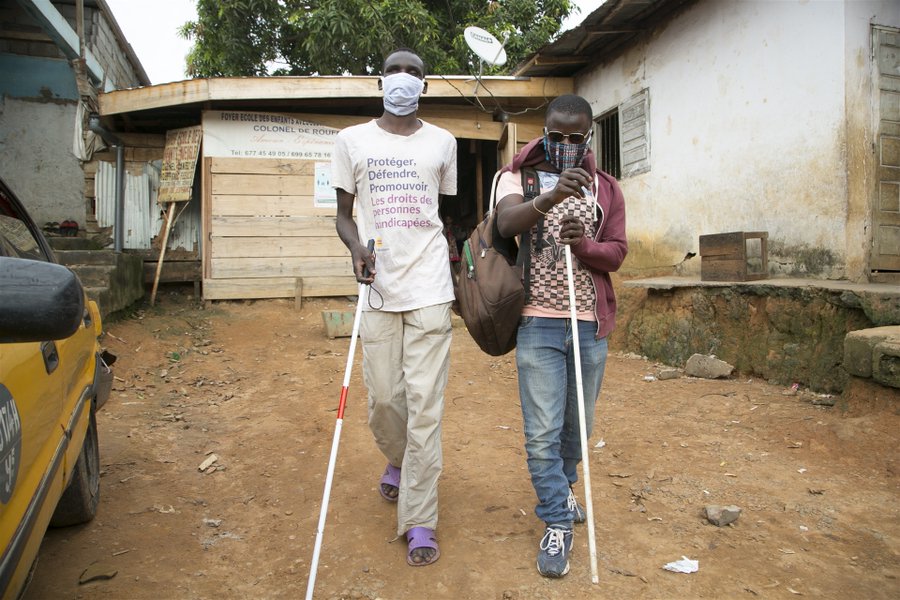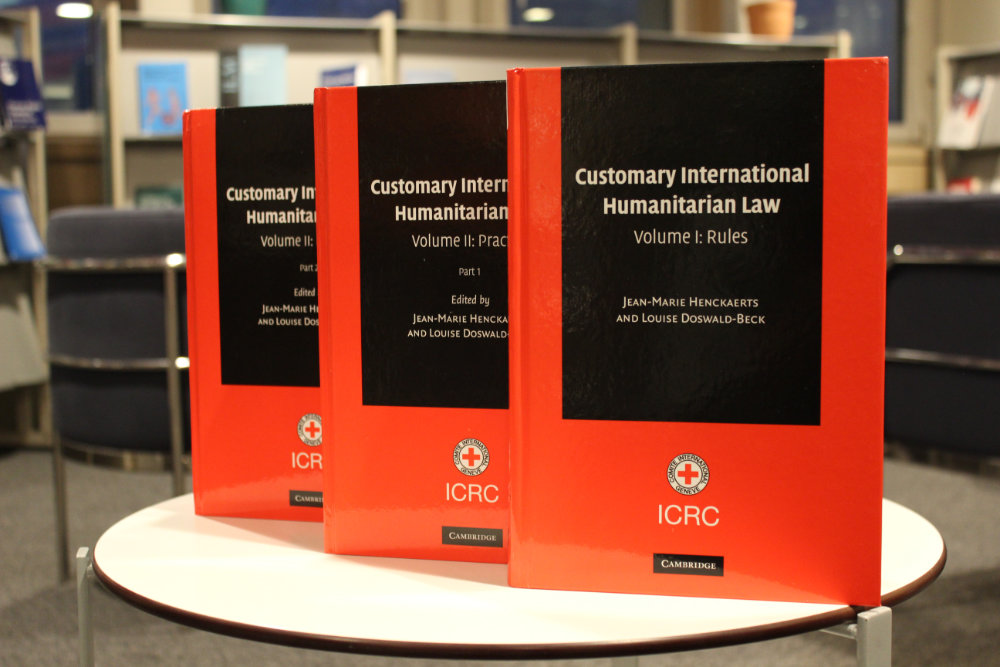Even with one in seven people worldwide living with some form of disability, this group has been largely invisible in the implementation of international humanitarian law (IHL) on the conduct of hostilities. Despite increasing recognition and calls for mainstreaming of the multiple and intersectional barriers and risks affecting persons with disabilities in armed conflict, their specific risks have not yet been taken into account when planning and conducting military operations.
In this post, Dr Helen Durham, ICRC’s Director of Law and Policy, and Professor Gerard Quinn, UN Special Rapporteur on the rights of persons with disabilities, explore how the complementarity between IHL and the UN Convention on the Rights of Persons with Disabilities can be used to increase the visibility of persons with disabilities within IHL, and analyze particular measures that can be taken in the conduct of hostilities to enable a more disability-inclusive implementation of the law of armed conflict.
Imagine this. The armed forces of one State launch a military operation to retake a city from the control of their adversary. The attack is planned on the assumption that the civilian population will have already evacuated, fled the area of hostilities or sought shelter in designated areas.
However, many people living with disabilities – part of any city’s population – have not been able to flee, as they weren’t able to access the warnings of the attack or the transportation to safely avoid them. In some cases, they have been abandoned by their families or other support persons, placing them at a higher risk during the military operation.
While other civilians who, for whatever reason, do not evacuate or flee manage to seek refuge in shelters, persons with physical or intellectual impairments may be unable to access these safe havens because of physical and communication barriers. Most basements have many stairs, and even the instructions on how to get to these types of shelters are often inaccessible.
A hypothetical scenario of very real risks
Unfortunately, this scenario doesn’t require much imagination.
A common pattern of barriers and risks are constantly faced by persons with disabilities in all armed conflicts, no matter the geographic location or the parties involved. The statistics of people living with disabilities are compelling (at least 15% of any given civilian population) and, due to the barriers they face, the number of them adversely affected during armed conflict are likely significant.
Conflict-specific barriers for people living with disabilities may be physical, such as difficulties in accessing services and aid, the loss of assistive devices, or the destruction of essential civilian infrastructure on which civilians with disabilities depend. They may be related to communications, such as the lack of accessible information on available shelter, evacuation routes or advance warnings of impending attacks. Or the barriers may be attitudinal, such as negative attitudes or misconceptions about persons with disabilities and bold assumptions that providing specific accommodations for them would be unrealistic or too high a burden during armed conflict.
Institutional measures could, in parallel, be cementing these barriers into place, such as a lack of considering people with disabilities in military doctrine, training, planning, or in the conduct of operations. Advance planning seems particularly impacted by the lack of quality data on which disability-inclusive strategies or programmes could be based.
Together, these barriers result in increased risks for people with disabilities of being killed or injured in military operations, subjected to violence, or unable to access humanitarian relief.
A more disability-inclusive implementation of IHL
All of the above occurs frequently during armed conflict, despite the fact that international humanitarian law (IHL) provides for a number of general and specific protections that are relevant in addressing the specific risks faced by persons with disabilities in military operations in armed conflict.
First and foremost, the general rules on the conduct of hostilities are as applicable to people with disabilities as any other part of the civilian population, notably the principles of distinction, proportionality, and precautions. Constant care must be taken to spare the civilian population in all military operations, and parties must take ‘all feasible precautions’ in attack to avoid or at least minimize incidental civilian harm and protect civilians under their control from the effects of attacks. ‘Feasible’ entails what is possible in practice, taking into account all of the humanitarian and military considerations that prevail at the time; this may be dynamic and evolve with time, including as a result of past practice and lessons learnt.
For instance, parties must give effective advance warnings of attacks that may affect the civilian population, unless the circumstances do not permit. The effectiveness of a warning should be assessed from the perspective of the civilian population that may be affected. It should reach and be understood by as many civilians as possible who may be affected by the attack, and it should give them time to leave, find shelter, or take other measures to protect themselves. Implementing such warnings in a disability-inclusive manner requires presenting accessible information in a variety of formats that would take into account the diversity of impairments of persons with disabilities. Radio messages alone will not be heard by people with hearing impairments. Leaflets or other exclusively visual forms of warning will not be seen by people with visual impairments. Complex instructions and warnings, if not simplified, will not be understood by people with intellectual impairments.
Feasible precautions may also include the construction of safe shelters or evacuations to allow civilians to leave for safer areas at their free will while military operations are ongoing. Taking such measures in a disability-inclusive manner means ensuring that safe shelters are physically accessible to wheelchair users or that information on their location be accessible for those with intellectual disabilities. It means giving specific consideration during evacuations to identify people with disabilities, ensuring accessible means of transport, allowing for their personal assistants and caretakers to accompany them, and ensuring that they are able to keep assistive devices with them or a suitable alternative in case those devices have been lost or damaged. Implementation of such measures will often be more effective if cooperative arrangements with civil authorities and other actors like organizations of persons with disabilities (OPDs) or impartial humanitarian organizations can be obtained.
Secondly, a more disability-inclusive interpretation of general IHL rules on the conduct of hostilities is also reinforced by a web of specific protections which apply to people with disabilities. These specific protections should not be viewed in isolation or as alternatives to general protection, but instead as recognizing that among the civilian population there are groups facing specific risks during armed conflict (e.g., women, older persons, children, and persons with disabilities). They underscore proactive efforts to identify people with disabilities among the civilian population and emphasize local agreements or arrangements, for instance for evacuations, to take these specific risks into account.
The essence of these specific protections is expressed by the obligation that people with disabilities are entitled to specific respect and protection. This obligation requires not only that parties to armed conflicts refrain from attacking, harming or ill-treating persons with disabilities, but also to taking active measures to assist and protect them from harm.
Additional rules concretely guide the implementation of this obligation, for example the requirement under the Fourth Geneva Convention (1949) to facilitate steps taken to assist civilians in grave danger. Negotiators at that time had the example of civilians trapped in air raid shelters in mind, but nothing precludes an interpretation of this provision to cover persons with disabilities or older persons who may be trapped in their homes during military operations.
Working in tandem: IHL and the UN Convention on the Rights of Persons with Disabilities
These general and specific obligations under IHL can come vividly to life and are powerfully reinforced by the UN Convention on the Rights of Persons with Disabilities (UN CRPD), which enjoys near universal ratification. The Convention radically re-frames disability and accentuates the moral agency of the person, situating people with disabilities not as objects to be managed or pitied, but subjects with equal human rights. States Parties are expected to take proactive measures to sensitize general laws and policies to the situation of persons with disabilities, and these latter are envisaged as partners and co-producers in the process of change.
Famously, Article 11 of the CRPD provides that States Parties shall take, in accordance with their international law obligations, including those under IHL and international human rights law, all necessary measures to ensure the protection and safety of persons with disabilities in situations of risk, including situations of armed conflict. Therefore, a more intentional disability-inclusive implementation of IHL is not only possible within the law of armed conflict, but also spurred on by the UN CRPD and its interaction with IHL. The UN CRPD helps draw out the latent potential of IHL to be more fully responsive to the situation faced by civilians with disabilities, all of which is powerfully reinforced by UN Security Council Resolution 2475 (2019) to the effect that the protection of civilians during conflict must also be inclusive of persons with disabilities.
The implications of this for IHL are twofold.
The first is substantive in nature. A deeper, ongoing and situation-specific analysis of the variety of barriers mentioned at the outset will contribute to a more granular assessment of the specific risks of civilians with disabilities during military operations. This is latent within IHL, but driven by the UN CRPD. For States Parties to the UN CRPD, this more granular analysis of specific barriers and risks faced by persons with disabilities is an obligation to collect disaggregated data to guide that analysis.
The second implication is more procedural in character, relating to the respect for the collective voice of persons with disabilities. Steps must be taken to ensure that people living with disabilities and their representative organizations can and do shape the interpretation and implementation of IHL norms relevant to them. This emphasis on a collective voice in the UN CRPD helps keep IHL norms relevant.
These implications are not to suggest that the UN CRPD will displace IHL, nor do they suggest the creation of new protections or even protected groups. Rather, both implications work in tandem to raise the visibility of the specific barriers and risks faced by people with disabilities during armed conflict and improve the implementation of IHL relevant to them.
A visibility project: bringing together people with disabilities and military representatives
In order to advance the visibility of disability within IHL, the ICRC, the UN Special Rapporteur, the International Disability Alliance and the Diakonia International Humanitarian Law Centre will bring together people with disabilities, their representative organizations and military representatives in a series of joint consultations in April and May 2022. These consultations aim to build the capacity of persons with disabilities and OPDs relating to IHL and military planning and operations, and sensitize military representatives to the specific barriers and risks faced by persons with disabilities in armed conflict.
We hope that this will mark the beginning of a conversation about challenges and solutions between stakeholders who have not yet engaged with each other, ultimately leading to military operations that are more inclusive of, and therefore less deadly for, persons with disabilities.
Some preliminary findings and recommendations from these discussions will be presented in the next report planned by the UN Special Rapporteur on the rights of persons with disabilities to the UN General Assembly on the topic in the fall of 2022. The ICRC, in parallel, will explore how to integrate some of the outcomes of these consultations into its own work aimed at becoming more disability-inclusive, consistent with the institutional ambitions outlined in its Vision 2030 on Disability.
Visibility and voice are cornerstones to keeping IHL relevant and connected to the lived experience of our civilian population, a population that includes more than one billion people living with disabilities in the world today.
See also
- NG’AA Michael Mwendwa, Disability and sexual violence in the COVID-19 era, December 3, 2020
- Jess Markt, COVID-19 and its impact on persons with disabilities, September 17, 2020
- Alexander Breitegger, Persons with disabilities in armed conflict, December 13, 2017







Comments